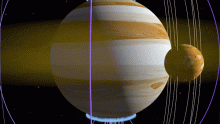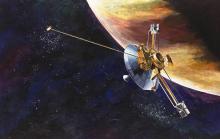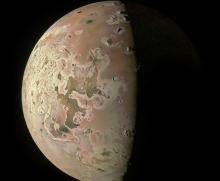Listen to today's episode of StarDate on the web the same day it airs in high-quality streaming audio without any extra ads or announcements. Choose a $8 one-month pass, or listen every day for a year for just $30.
You are here
Mercury and Jupiter
Two planets that are a study in contrasts will cross paths in the dawn twilight the next few days. They’re fairly easy to spot from some locations, but not from others.
Mercury and Jupiter are at opposite ends of the planetary scale in just about every aspect. Mercury is the smallest planet in the solar system, while Jupiter is the largest. Mercury is a ball of rock, while Jupiter is a ball of gas. Mercury is roasted by the heat of the nearby Sun, while Jupiter gets more warmth from its own interior than from the Sun.
Much of that is a reflection of where they were born. Mercury formed close to the Sun. The Sun’s radiation and winds blew lightweight materials away from that region. That left only heavy grains of solid material to come together to make planets.
Jupiter was born much farther out, where it was colder and calmer. Solid grains came together to form the planet’s core. As the core grew, it swept up the lighter elements around it — especially hydrogen and helium, the lightest of all.
So Mercury and Jupiter became quite different worlds — a study in contrasts.
Look for them low in the east-southeast in the dawn twilight. Jupiter is the brighter of the two. Tomorrow, Mercury will stand close above it. Mercury and Jupiter will appear to almost touch each other on Friday. Mercury will move away from Jupiter after that. The planets are much easier to see from more southerly latitudes, where they rise at a better angle.





